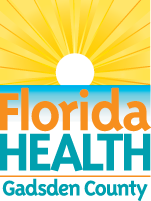It's a New Day in Public Health.
The Florida Department of Health works to protect, promote, and improve the health of all people in Florida through integrated state, county, and community efforts.
Tuberculosis
Florida Department of Health in Gadsden County
- 850-875-7200
- GCHDMailbox@FLhealth.gov
-
Fax
850-875-7210 -
Mailing Address
278 Lasalle Leffall Drive
Quincy, FL 32351
The Tuberculosis program provides a broad range of services to people in Gadsden County. Our Outreach Program consists of the comprehensive case management of active cases of TB, investigation, and testing of those exposed to an active case of TB, along with direct observed medication therapy (DOT) of active TB cases. In addition, Outreach acts as a gateway to treatment in the TB clinic for those who have been determined through testing to have Latent TB infection.
Our Clinical Services provide the diagnosis and treatment of persons with active TB disease and persons identified with latent TB infection. Treatment for persons identified with latent TB infection will be crucial to achieving the ultimate goal of eliminating TB as a public health threat in Florida.
A basic premise of the Technical Assistance (TA) guidelines and current CDC guidelines are: TB blood tests (also called interferon-gamma release assays or IGRAs) measure how the immune system reacts to the bacteria that cause TB. An IGRA measures how strong a person's immune system reacts to TB bacteria by testing the person's blood in a laboratory. The TB skin test (also called the Mantoux tuberculin skin test) is performed by injecting a small amount of fluid (called tuberculin) into the skin in the lower part of the arm. A person given the tuberculin skin test must return within 48 to 72 hours to have a trained health care worker look for a reaction on the arm. The health care worker will look for a raised, hard area or swelling, and if present, measure its size using a ruler. Redness by itself is not considered part of the reaction.
The skin test result depends on the size of the raised, hard area or swelling. It also depends on the person's risk of being infected with TB bacteria and the progression to TB disease if infected.
Services
The TB Clinic helps Health Care Providers and patients defeat Tuberculosis (TB) by providing:
- Complete diagnosis and treatment of Tuberculosis (TB) Disease
- Complete diagnosis and treatment of Latent Tuberculosis Infection (LTBI)
- Case management
- Thorough contact investigation with testing of everyone exposed
- Direct observed therapy monitoring (DOT) - intake of medication among patients with Tuberculosis (TB) Disease
- Education and information services for clients and families
- Surveillance - active observation of Tuberculosis (TB) client activities
Symptoms
Tuberculosis (TB) can infect almost any part of the body including, but not limited to, the lungs, heart, brain, bone, spine, stomach, kidneys, and fallopian tubes. The most common of these is Pulmonary Tuberculosis (TB) which occurs when the organism infects the lungs. Symptoms include:
- A cough, which can be dry or accompanied with phlegm
- Coughing up blood
- Fluid in the lungs
- Mild fever
- Headache
- Chills
- Night Sweats
- Malaise (general unwell feeling)
- Fatigue
- Loss of appetite
- Weight loss
- Chest pain from pleurisy
- Difficulty breathing
- Swollen glands
Symptoms of TB disease in other parts of the body depend on the area affected.
It is important to understand that many of these symptoms may also be present in a variety of other medical conditions. Often, Tuberculosis (TB) is not suspected until other more common conditions are treated without success.
Risk Factors
People who have Latent Tuberculosis Infection (LTBI) have had a positive skin test in the past, but have not developed Tuberculosis (TB) Disease. However, people with certain conditions are at risk. These include:
- People who are HIV positive
- People who became infected with Tuberculosis (TB) in the last 2 years
- People who were not treated correctly for Tuberculosis (TB) in the past
- People with medical conditions that make the body less able to protect itself from disease.
- Injection (IV) drug users
- Babies, young children, and seniors
- People living in closed quarters. i.e. Jails, prisons.
If you have Latent Tuberculosis Infection (LTBI) and you have any of these risk factors you need to seek treatment from a health care provider. They can help you decide which treatment is best for you.
TB Prevention
- See your health care provider for regular check-ups
- Take all of your medicine until finished, even if you are feeling better and have no more symptoms.
- Report any side effects right away (loss of appetite, nausea, vomiting, yellowish skin or eyes, fever for more than 3 days, abdominal pain, tingling in the fingers and toes)
- Abstain from drinking alcohol until medication is complete or doctor has cleared you
- Wear a surgical mask.
- Always cover your mouth with a tissue when you cough, sneeze, or laugh. Place the tissue in a closed bag and throw it away.
- Stay home if you are sick. Separate yourself from others and avoid close contact with anyone. Sleep in a bedroom away from other family members.
- Air out your room often. Tuberculosis (TB) spreads in small closed spaces where the air does not circulate.
- Put a fan in your window to blow out air that may be filled with Tuberculosis (TB) bacteria.
- If you are sick enough, go to the hospital so you can be separated from others- reducing their chance to get Tuberculosis (TB) Infection.
Remember Tuberculosis (TB) is spread through the air! It is not spread through handshakes, sitting on toilet seats, or sharing dishes and utensils.




Connect with DOH